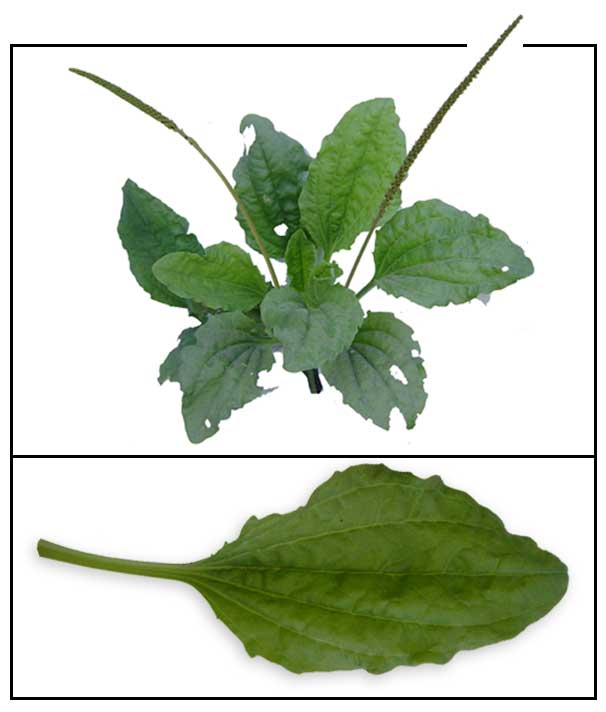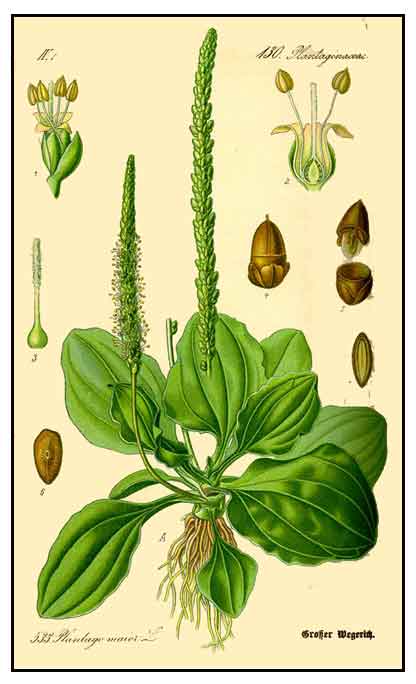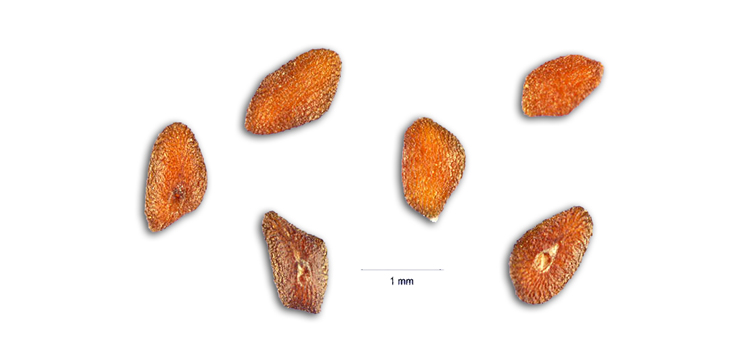|
Etymology
- First cultivated nearly 4000 years ago. European Indians called it "White man's footprint' because it was found everywhere the Europeans had been, and from that derives the genus name, Plantago, meaning sole of the foot. (25)
 Botany Botany
Lanting is a perennial herb with the leaves occurring in a rosette near the ground. Leaves are oblong or oblong-ovate, 5 to 10 centimeters long, with
entire or toothed margins, usually 5-nerved, and borne on petiole
often as long as the leaf blades. Flowers are usually in crowded on erect, slender spikes,
6 to 12 centimeters long. Corolla is small and smooth, with the lobes spreading
or reflexed. Sepals are ciliated. Fruits are capsules, ovoid, about 3 millimeters long and containing
2 cells. Each cell has 4 to 8 angular, very minute, black seeds.
Distribution
- Occasionally in wastelands in and about towns, at medium
altitudes, thoroughly naturalized.
- Probably introduced from Europe.
- Now a weed in most or all warm countries.
- Pollinated by wind; each plant can produced 20,000 seeds.
Constituents
- Plant contains a large amount of potassium salts and citric acid.
- Seed yield 16.7 to 22.1% of fixed oil.
- Leaves, roots, and flowers yield a glucoside, aucubin, and enzymes invertin and emulsin.
- Seed yield aucubin, choline, and organic acids succinic and platenollic acids.
- Contains polysaccharides, lipids, caffeic acid derivatives, flavonoids,
iridoid glycosides and terpenoides.
- Phytochemical studies have yielded apigenin, baicalein, benzoic
acid, chlorogenic acid, citric acid ferulic acid, salicylic acid, ursolic
acid.
- Studies have revealed Aucubin, a glycoside, reported as a powerful
antitoxin.
- Methanol extract of Plantago major subsp. intermedia (Gilib.) Lange yielded 4 known compounds: isomartynoside, 10-hydroxymajoroside, β-sitosterol, and ursolic acid.
- Seeds yielded fatty acids: myristic acid, palmitic acid, stearic acid, oleic acid, linoleic acid, linolenic acid, arachidic acid, behenic acid, lignoceri acid, and 9-hydroxy-cis-11-octadecenoic acid. (25)
- GC-MS analysis of various extracts of leaves yielded main constituents as follows: phytol 13.22%, benzofuranone 10.48%, penthynediol 10.26%, and benzene propanoic acid 10.81% in the petroleum ether extract; diglycerol 30.31% and glycol 18.91%, in the methanol extract; glycerine 30.70%, benzene 21.81%, and dibuthyl phthalate 16.22% in the ethyl acetate extract;
phthalic acid 24.62%, benezene propanoic acid 16.83%, in n-butanol extract; phenol 27.47%, diathiapentene 14.53%, napthalenone 14.31%, and glycerine 12.02% in the aqueous extract. The different chemical compositions are due to different polarity of the extraction solvent. (29)
 Properties Properties
- Slightly
sweet, cooling.
- Considered antidote, antipyretic, astringent, diuretic, laxative,
lymph deobstruent, ophthalmic, stomachic, vermifuge.
- Leaves considered emollient.
- Leaves reported as saline, bitter, and acid; the root saline and sweetish to taste.
- Seeds considered pectoral, demulcent, antidysenteric, mucilaginous, diuretic and antirheumatic.
Parts
utilized
Seeds, roots, leaves.
Uses
Edibility / Nutrition
- Edible: Leaves, roots, seeds.
- Young leaves, raw in salad or cooked as pot herb.
- Rich in vitamin B1 and riboflavin.
Folkloric
· For centuries, used as wound healing remedy in most parts of the world. The Norwegians ad Swedes referred to it as groblad, meaning 'healing leaves.' (25)
· For boils, furuncles, and abscesses, lesions are covered with fresh crushed material.
· Anuria and dysuria due to beriberi: Concentrated decoction
of the whole plant or seeds. Use 9 to 15 gms of the whole plant or 6
to 12 gms of seeds.
- Decoction of plant used for asthma.
- Decoction of leaves used as emollient.
- Severe cough with plenty of phlegm which cannot be smoothly
expectorated: Concentrated decoction of the whole plant or seeds with
bark of Morus alba
- Insomnia, bloody urine, urinary lithiasis, nephritic edema,
beriberi edema, hypertension, bronchitis: Decoction of 30 to 60 gms
of dried or 30 to 90 gms of fresh material.
- Reddening and swelling pain of the eye.
- For furuncles, eczema and various skin irritation: Poultice
of pounded fresh material.
- Gum inflammation
or gingivitis: Use decoction as mouth wash or as gargle.
- Skin irritation: Apply decoction over affected area. The
powdered seeds may be mixed with oil for treatment of dermatitis.
- Used as antidote and diuretic. Also
used as poultice for sores, particularly inflamed fingernails. A watery
extract of the seeds is given for whooping cough. To purify blood, stomachaches,
and malaria, the whole plant is boiled and the decoction is taken internally
as a diuretic for stone in the bladder.
- Decoction of root reported to cause a natural aversion to tobacco
and used as an ingredient in smoking-cessation preparations.
- Decoction of leaves used as antidysenteric and vulnerary; used in burns, contusions, and ulcers of the mouth.
- Roots and leaves used to relieve coughs and consumption.
- Used for wasting diseases in men and women; promotes secretion
of semen and conducive to fertility.
- Used to nourish the liver, assist in difficult labor.
- Malays used a decoction leaves
for dysentery and gonorrhea.
- Leaves used as poultices for sores, particularly for inflamed fingernails.
- In Japan, watery extract of seed used for whooping cough.
- Zulus squeezed the leaf juice into the mouth and ears. Europeans used fresh leaf juice as a remedy for malaria.
- Transvaal Europeans plug the ears with the leaf to relive earache.
- Mucilaginous leaves are roots used as astringent and febrifuge.
- In Java
used for diuretic for bladder stones. Used in decoction for diabetes, worms, hemorrhoids, and to purify the blood.
- In Romania
and Bulgaria, used for
cuts and scratches.
- In Ayurveda,
used for constipation, diarrhea, dysentery.
- In China, used
for colds and viral hepatitis.
- In Malaysia, used for treating diabetes and to increase male fertility.
- In Taiwan, used for treating respiratory, urinary and digestive tract infectious diseases.
- In Guatemala and Turkey, used for acne.
In India, used for bee, wasp, and nettle stings. In Turkey, used for the treatment of ulcers—the powdered leaf taken with honey daily before breakfast. (25)
- In traditional Persian medicine, drops or massage of mucilage used for earaches or nasal inhalation. Leaf juice used for treatment of various eye diseases i.e., choroid diseases, day blindness, eye sores, and conjunctivitis. Gargle of leaf juice used for toothache, halitosis, epistaxis, loose teeth, gingivitis, and tonsillitis. Leaf extract used for treating asthma, tuberculosis, and various lung lesions. Also used for treating uterine warts, menometrorrhagia and polymenorrhea, wounds and skin diseases. (33)
 Studies Studies
• Review: The traditional
uses, chemical constituents and biological activities of Plantago major
L. A review: Well known in traditional medicine as a wound healing remedy.
Studies have yielded biologically active compounds and a range of biologic
activities as wound healing, anti inflammatory, antioxidant, analgesic, antiulcerogenic activity. (1)
• Anti-Urolithiatic: Plantago major was better than allopurinol and potassium citrate in inhibiting
the size of calcium oxalate crystals in vivo. (2)
• Immunoenhancing / Leaves: Plantago
major leaves have been attributed antiinflammatory, antimicrobial, antitumor
and wound healing properties. A methanol extract study of its leaves
showed increases of nitric-oxide production, increase in TNF-a production.
Study suggests the a regulation of immune parameters induced by plant
extracts may be clinically involved in numerous diseases including chronic
viral infections, TB, AIDS and cancer. (3)
• Antibacterial: The methanol and ethanol
extracts of PM showed antibacterial activity against S. aureus and E
coli. (4) In an antibacterial study of Plantago major and Ceratonia siliqua against six types of bacteria viz., Lactobacillus sp., S. aureus, Proteus sp., P. aeruginosa, E. coli, and Enterococcus sp., the methanol extract of P. major showed more antibacterial activity. (30)
• Antiviral Activity:
Study showed phenolic compounds to be responsible for PM antiviral activities
against herpesvirus-2 and adenovirus-3. (5)
• Smoking Cessation: (US
Patent 6063401) - Plantago major and hypericum perforatum compound for
use in treating a tobacco or nicotine habit – Patented claims
on the use of P major and H perforatum as a smoking cessation preparation. (7)
• Analgesic / Antiinflammatory / Leaves:
A study of the aqueous extract of dried ground leaves on rats
showed effective antiinflammatory and analgesic activities. (8)
• No Diuretic Effect: In a study of four traditional Vietnamese herbal remedies (Z mays, I cylindrica, Plantago major, O stamineus) claiming to increase diuresis, no diuretic effect was seen in a placebo-controlled double-blind crossover model. (9)
• Hypoglycemic / Spermatogenic Effect: Study to evaluate its traditional use for diabetes and male fertility showed the aqueous leaf extract of PM could contain chemicals for treating diabetes and male infertility problems. (10)
• Anti-Cancer: Study results showed that the PM extract had an inhibitory effect on Ehrlich ascites carcinoma and proposes an potential agent for cancer prevention. (11)
• Antimicrobial: Study of several folk medicinal plants, including the ethanolic extract of PM, tested against several organisms, all showed higher antibacterial activity against E coli and S aureus. (12)
• Anticancer / Antiviral / Immunmodulatory: Study of the hot water extracts of P major and P asiatica showed a broad spectrum of anti-leukemic, anticarcinoma and antiviral activities, as well as modulation of cell-mediated immunity. (13)
• Hepatoprotective / Anti-Inflammatory / Carbon Tetrachloride Toxicity: Study evaluated the anti-inflammatory and hepatoprotective activities of Plantago major in CCl4-induced hepatotoxicity. Plantago major treated group showed significantly reduced ALT and AST when compared to the CCL4 group, along with histopathological differences in the PM and CCl4 groups. (14)
• Hematopoietic Activity: Study of the extracts of the aerial parts (leaves and seeds) of PM, added to mice bone marrow and spleen cultures, E coli, B subtilis and C albicans cultures, showed bone marrow and spleen cell concentration and inhibition of the bacterial growths. Data demonstrates for the first time that PM has hematopoietic activity in vitro.
• Biochemical Studies: In an analysis for general chemical components, leaves yielded a high percentage of linolenic acid, 56.19% while seeds yielded 25.41%. Total phenols, flavonoids and tannin were highest in the Plantago leaves. (16)
• Antioxidant / Isomartynoside: Study of P. major subsp. intermedia showed antioxidant activity, probably related to the presence of phenylpropanoid glycoside, isomartynoside. (17)
• Anti-Urolithiatic Terpenoid: A methanol extract yielded an active terpenoid. The inhibition effect of the terpenoid of Plantago major extract on crystal size was much better than Zyloric and potassium citrate. (18)
• Antitumoral / Ehrlich Ascites Tumor: Study of P. major extract in Ehrlich ascites tumor in mice showed a dose-dependent inhibitory effect on EAT. (19)
• Wound Healing: Study of different leaf extracts from fresh and dried leaves in an in vitro scratch assay showed both water extracts and the more poly-phenol-rich ethanol extracts showed increased proliferation/migration of oral epithelial cells suggesting a wound healing effect. (20)
• Anticarcinogenesis: Study in Swiss albino rats administered DMBA evaluated the effect of Pm extract on serum total sialic acid, lipid-bound SA and other trace elements. Results suggest PM may be partially effective in preventing carcinogenesis initiated by environmental carcinogen DMBA.
• Inhibition of ROS: Study evaluated the in vivo effects of P. major extract, baicalein, and aucubin on human neutrophil respiratory burst activity. Results showed P major extract inhibited neutrophil ROS production, as did aucubin and baicalein, and suggest further study in its relation to the regulation of destructive ROS production in conditions such as periodontal disease. (22)
• Inhibition of AOM-Induced ACF via Apoptosis / Colon Cancer: Study showed anti-colon cancer effects through inhibition of AOM (Azoxymethane)-induced ACF( aberrant crypt foci) via apoptosis, and suggests a potential for a chemopreventive and potential therapeutic agent for colon cancer. (23)
• Interaction with Anticoagulants: Moderate interaction concerns with warfarin. Plantain contains large amounts of vitamin. By helping the blood clot, it might decrease the effectiveness of warfarin (coumadin). Dose of coumadin may need to be changed. (26)
• Hepatoprotective / Drug-Induced Hepatotoxicity: Study evaluated an ethanol extract on Omeprazole and Ciprofibrate induced hepatotoxicity in a rat model. Results showed hepatoprotective activity as evidenced by reduction in hepatic transaminases and improvement in histopathologic appearances of liver. (31)
• Antimicrobial / Synergism / Antioxidant / Leaves: Study evaluated different leaf extracts for antioxidant and antibacterial properties using in vitro methods. An ethyl acetate fractions showed the highest DPPH scavenging capacity (IC50-12.85±0.27 µg/ml) and relative antioxidant activity of 70.48% in the ß-carotene bleaching assay. The ethyl acetate fraction was also the most active in vitro against Gram-negative and Gram-positive bacteria. Synergistic antibacterial activity was seen by combination of standard antibiotic (gentamicin) with the tested extracts. (32)
• Anti-Inflammatory / Attenuation of Inflammatory Reaction in Experimental Acetaminophen Induced Liver Injury / Leaves: Study evaluated the anti-inflammatory property of P. mojor leaf extracts on inflammatory reaction following APAP hepatotoxicity in Sprague-Dawley rats. Extract treatment significantly reduced proinflammatory cytokine levels and significantly reduced 11ß-HSD type 1 enzyme activity (p<0.05). (34)
• Ursolic Acid / COX-2 Inhibition: Study of a hexane extract of P. major by bioactivity-directed fractionation isolated ursolic acid. The triterpenoid showed a significant COX-2 inhibitory effect, directly on enzyme activity, with IC50 of 130 µM and a COX-2/COX-1 selectivity ration of 0.6. (36)
• Wound Healing Effect / Mixture of P. major and Aloe vera: Stereological study evaluated the effects of P. major and Aloe vera mixture in the process of wound healing in a model of excisional full thickness skin wounds in Sprague Dawley rats. Results suggest the mixture has the ability to improve wound healing by enhancing fibroblast proliferation, collagen bundle synthesis, and re-vascularization in skin injuries. (37)
• Antifungal / Candia albicans: Study evaluated the antifungal activity of bark of G. glabra, stem of F. religiosa, and husk of Plantago major on inhibiting Candida albicans using Kirb-Bauer disc diffusion method. While G. glabra showed to be most effective, P. major and F. religiosa showed acceptable potency to C. albicans comparable to that of synthetic antifungal agents. (38)
• Nephroprotective / Cisplatin Induced Renal Dysfunction: Study evaluated the nephroprotective effect of P. major on cisplatin-induced kidney injury in rat. Cisplatin caused a significant decrease in GFR, urine osmolarity, and urinary excretion rte of potassium, along with significant increase in kidney index and histological damage. Administration of P. major significantly increased GFE, urine osmolarity and urinary excretion rate of potassium. Results suggested a dose=dependent protection against renal damage induced by cisplatin. (39)
• P. major and Aloe vera (Plantavera) Gel in Diabetic Foot Ulcer / Clinical Trial: A double-blind, randomized clinical trial evaluated the efficacy of Aloe vera and Plantago major gel in healing of diabetic foot ulcer. Results showed a significant difference in measures of total ulcer score (p<0.001) and the Plantavera gel significantly reduced the ulcer surface. Results suggest the topical Plantavera gel is an effective, cheap, and safe treatment. (40)
• Effect on Candida albicans, Biofilm Formation / Aucubin and Baicalein:. Study showed P. major extract, aucubin, and baicalein caused a dose=dependent reduction on total growth, biofilm formation, metabolic activity and cell surface hydrophobicity of Candida albicans. Results suggest promising potential as antifungals and solutions for C. albicans biofilm related infections. (41)
• Effect on Proliferation of Cancer Cells and Cytokines Production: Study evaluated the antiproliferative activity of P. major extracts against MCF-7, MDA-MB-231, HeLaS3, A549, and KB cancer cell lines as well as effects on inflammatory cytokines production by lipopolysaccharides (LPS)-stimulated THP-1 macrophages. Results showed methanol and aqueous extracts of P. major seeds exhibited greatest antiproliferative activity. The ME also demonstrated highest inhibition of TNF-α, IL-1ß, IL-6, and IFN-g production. (42)
• Multisubstrate Reductase: Study identified a putative 5ß-progesterone reductase gene, PmMOR (P. major multisubstrate oxido-reductase), that is 60% identical to the iridoid synthase gene from Catharanthus roseus. The enzyme showed promiscuous enzymatic activity, reduced progesterone and crital, and also catalyzed the reductive cyclisation of 8-oxogeranial. (43)
• Antidiabetic / Leaves: Study evaluated the antidiabetic activity of methanolic extract of leaves of Plantago major in stretozotocin-induced diabetic Wistar rats. The methanolic extract at dose of 200 mg/kg produced a significant reduction in fasting blood glucose level, along with significant differences in urine glucose level, OGTT, serum lipid profile and body weight of extract treated rats. (44)
• Anxiolytic / Role of Adrenergic System / Leaves: Study evaluated the hydroalcoholic extract for effect on level of anxiety in male Wistar rats. Results showed P. major extract at doses of 100 and 200 mg/kg significantly (p<0.05) caused an anxiolytic effect. Epinephrine prevented te anxiolytic effects of plantago. Results suggest flavonoid compounds in the leaf extract such as apigenin and its interaction with the adrenergic system may create the anxiolytic effects. (45)
Availability
Wild-crafted.
Oil and leaf extracts in the cybermarket. |


![]()

